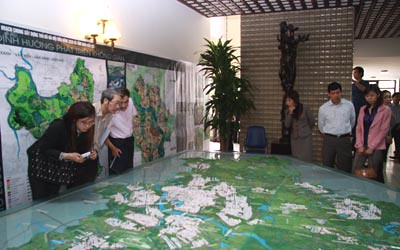Deputies have agreed on the need for a master plan for the capital city until 2030 and vision to 2050.

Minister of Construction Nguyen Hong Quan had earlier made clear a number of issues relating to the master plan.
He stressed the whole city of Hanoi was regarded as the political and administrative center of Viet Nam, not any district or precinct within the city, so whichever location was chosen for the administration precinct, it would still be in Ha Noi.
Deputies Nguyen Van Hop from the Song Hong (Red River) Delta of Hai Duong and Scom Sa Duyen from the Tay Nguyen (Central Highlands) province of Gia Lai said the master plan should conserve traditional characteristics and consider socio-economic development of the city's rural areas.
Deputies said a detailed study of Hanoi's rural areas was important to create harmony between urban and rural development.
They urged planners to avoid conflict between the Hanoi master plan and the capital region plan.
Deputies focused mostly on two issues: the location for a national administration precinct and transportation.
Deputies said Viet Nam should have an administrative precinct befitting a proud nation with a rich history and unique culture, not to mention its enhanced status in the region.
Many didn't support the master plan proposal that the headquarters of key government agencies and cultural centers be moved to Ba Vi, a rural district of the capital, while the political hub remained in Ba Dinh Precinct.
Those against the proposal included Nguyen Minh Thuyet from northern border Lang Son Province, Nguyen Van Hop from Hai Duong, and Ngo Thi Minh from the northern mining province of Quang Ninh.
The latter suggested the political and administrative centers should be together in Ba Dinh or My Dinh.
In discussion on transport development, Deputy Nguyen Minh Thuyet rejected the idea of building the Thang Long road axis by 2050 as mentioned in the master plan's view to 2050.
He argued there were already two roads running in that direction: the Lang-Hoa Lac expressway and National Highway 32.
Deputies agreed transport development must create harmony between rail, road, air and waterways.
Meanwhile, some deputies asked planners to come up with flood prevention and diversion measures.
Source: SGGP

Minister of Construction Nguyen Hong Quan had earlier made clear a number of issues relating to the master plan.
He stressed the whole city of Hanoi was regarded as the political and administrative center of Viet Nam, not any district or precinct within the city, so whichever location was chosen for the administration precinct, it would still be in Ha Noi.
Deputies Nguyen Van Hop from the Song Hong (Red River) Delta of Hai Duong and Scom Sa Duyen from the Tay Nguyen (Central Highlands) province of Gia Lai said the master plan should conserve traditional characteristics and consider socio-economic development of the city's rural areas.
Deputies said a detailed study of Hanoi's rural areas was important to create harmony between urban and rural development.
They urged planners to avoid conflict between the Hanoi master plan and the capital region plan.
Deputies focused mostly on two issues: the location for a national administration precinct and transportation.
Deputies said Viet Nam should have an administrative precinct befitting a proud nation with a rich history and unique culture, not to mention its enhanced status in the region.
Many didn't support the master plan proposal that the headquarters of key government agencies and cultural centers be moved to Ba Vi, a rural district of the capital, while the political hub remained in Ba Dinh Precinct.
Those against the proposal included Nguyen Minh Thuyet from northern border Lang Son Province, Nguyen Van Hop from Hai Duong, and Ngo Thi Minh from the northern mining province of Quang Ninh.
The latter suggested the political and administrative centers should be together in Ba Dinh or My Dinh.
In discussion on transport development, Deputy Nguyen Minh Thuyet rejected the idea of building the Thang Long road axis by 2050 as mentioned in the master plan's view to 2050.
He argued there were already two roads running in that direction: the Lang-Hoa Lac expressway and National Highway 32.
Deputies agreed transport development must create harmony between rail, road, air and waterways.
Meanwhile, some deputies asked planners to come up with flood prevention and diversion measures.
Source: SGGP

Post a Comment
Post a Comment